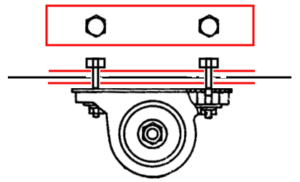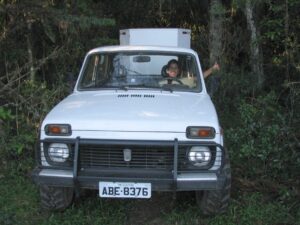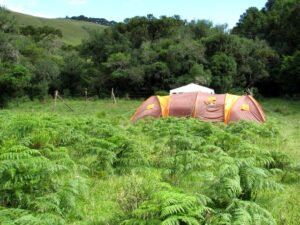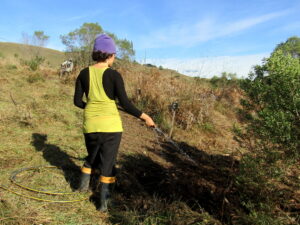The first thing to do this week was to get our gambiarra fixed up by a real mechanic! Here’s a simple diagram of what would probably be the cheapest way to get it fixed which wouldn’t require any welding or any extra bolts – we could do this ourselves, but without proper tools and a workshop it’d just be frustrating 🙁 Here’s some diagrams I made of how we thought it should be fixed and a photo of the work the mechanic did.



We decided to get a bigger hammer with a “waffle face” for hammering in large nails because when we were building the bridge I bent a lot of big nails trying to hammer them in with a normal sized hammer. The waffle face causes the hammer’s head to bite into the nail head preventing it from slipping. I also bought some big nails so we can nail logs together – really big nails!



The rest of the week was just work as usual until Friday late morning when we set off back to the land. This weekend’s project was to clear a path through our bush area so we can get our car and trailer into our “island” where our tent is. There’s a reasonably clear route through the trees which only required a few small trees to be chopped down, but two large fallen trees needed to be cleared which was the main work. The first one was quite soft and rotten, so I did this first to get some practice with the chainsaw. The second one was more difficult as it was a large thick tree trunk across the path at about head height made of very hard wood. Apart from getting the chain jammed at one point and having to cut the chainsaw free with the axe!



Next we bought the trailer through our newly cleared path – this was a bit difficult and needed a bit of on-the-fly chopping and we had to unhook the trailer, reposition the car and re-hook it a couple of times, so we’ll need to make some parts a bit wider before getting the trailer through again. It’s no problem for the car by itself though, but the trailer’s quite long and wide so is much more of a problem.






It was very tiring work doing so much axing and chainsawing on Friday and Saturday, so on Sunday we had a bit of a rest, but even that turned into a drama! as we were drinking coffee after breakfast I saw a scorpion scuttle past – in the tent! we couldn’t find it after that, so though that we’d be best to clean the tent up a bit since there were lots of plastic bags around, and a pile of fire wood in one corner which in hindsight was really asking for trouble. Finally Beth found it hiding under the toothbrush bag! I put a glass over it and slid some cardboard under it so I could take it and throw it in the bush on the swamp side where we don’t go. As we cleaned up the tent we found two more scorpions! we didn’t get any photos unfortunately because we were too stressed out to think about it, but here’s a picture I found of our kind which are about two inches long.
After reading up a bit more on scorpions, we feel a lot less stressed about them. First, unlike how the movies portray them, they’re actually quite passive creatures (well our kind are anyway), they don’t move very quickly and only sting when they’re hurt – similar to wasps. I found this to be the case when I trapped it in the glass (I even accidentally dropped one of them again and had to re-trap it), it didn’t go psycho and start attacking everything in sight, it just wandered about fairly calmly since I had taken care not to hurt it. Also we found out that the likely reason they were in our tent was because over the weeks we’ve accumulated some cockroaches from not keeping the tent area tidy enough, and scorpions favourite food is cockroaches! so the bottom line is; scorpions are ok 🙂
Shortly after the scorpion incident we were back to our coffees when we heard some branches shaking in the top of a tall Araucaria tree close by (we have many of these very interesting trees on our land which have edible nuts very similar to chestnuts). We soon saw that there were a group of monkeys playing up there! they were moving about pretty quick so only a couple of the photos showed them clearly. They’re Bugio-ruivo monkeys which are very popular in the native bush of Argentina and southern Brazil.
There’s a huge amount of ferns in the native bush of southern Brazil as can be seen from the first picture below, but what I miss is Ponga trees, or in fact any tree ferns – there’s not very many of them around in the natural bush at all for some reason. But yesterday I cam across a single one next to our river, so I’m thinking about getting some cuttings from it to see if I can spread them round a bit 🙂












